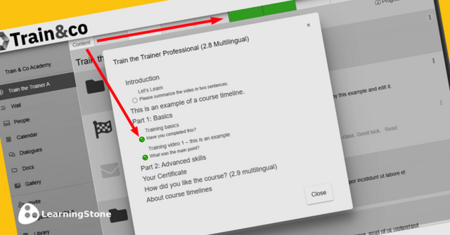
1. ‘I'll be replaced by a machine’
An understandable, human fear. And justifiable too! Some work will indeed be taken over… but hey, computers are better at some things, aren’t they? Isn’t it great – just to mention an example – that something can be recorded on video and watched at home. And lots of administrative jobs can be automated. Yes, the machine sometimes replaces you, but above all it saves you lots of time.

2. ‘I find it too complicated’
Blended learning can indeed feel complicated in the beginning, especially if you want to know everything right away. Our advice: start simple. Slowly but surely you’ll discover new possibilities. It is logical that you will not use the full potential of the technology immediately when you switch to blended learning. We know users who don't use any of the more advanced feature available, even after years and still work successfully with blended learning.

3. ‘I like people, not computers’
We understand that you became a trainer because you love people. 'I'm a peoples person. Not a computer person!" is something we definitely recognize. But als a peoples person can create better training by going blended.
You can actually deepen that love of people with the help of computers, because you save time by letting the computer do the tedious, repetitive chores. We see successful examples of blended learning by trainers who rely primarily on the collaboration features of online systems. Deploying digital tools without passion for the end user is doomed to failure.

4. 'I'm afraid to learn new things'
[No Comment]

5. 'Will take way too much time'
Indeed it will take you more time in the beginning, to go blended. You have to setup the system. Adjust the learning design. But that's going to pay for itself. The goal of blended learning is that you improve the quality and efficiency of the training. You can learn it all gradually, at your own pace.

6. 'Fear of the unknown. What is that then, blended learning?'
Realize that the smartphone hasn't even been around that long either. Now you can't and won't live without it. Getting used to blended learning happens at lightning speed. The iPhone was also only introduced in 2007.

7. 'Then I have to change everything'
Stepping out of your comfort zone is annoying. You don't have to throw everything out straight away. You can take it one step at a time.

8 'It's expensive'
Your training is going to make more money as a blended training. You have to weigh the costs against the benefits. You end up comparing the net result of traditional training with the blended version. In terms of distribution of learning materials alone, you can actually save money right away. At LearningStone, for example, we once got a new customer when the lease on his printer happened to end. It turned out to be cheaper to use LearningStone than to renew the lease. Now the customer doesn't want anything else - and they have gradually adopted blended training.

9. 'Too much hassle to switch to blended learning now’
It's profitable work. Within three months, it's not only going to make money, but more importantly, it's going to save a lot of time. If your business model is right, you're going to earn right away with blended learning. You may suddenly find yourself with new or different clients. Your blended design greatly increases the potential for your customers.

10. 'Then they'll steal my idea, because everything is online'
The biggest contribution to training comes from the trainer, not the learning materials. You are the link between content and your trainee. LearningStone is a secure system so it’s not public. The fear that someone might steal your idea and your training is understandable, but it never really happens.
11. 'My trainees really don't want it'
In certain cases, you may be right. But how do you know? If people don't have a smartphone or computer, you shouldn't use digital tools. You should only do this if it really makes sense. If your trainees are not very digitally savvy, you should work extra hard to keep the online program uncluttered. We see that because of covid, many trainees are already more accustomed to digital means than there were a few years ago.

12. ‘I’ll get copyright issues with my material.’
LearningStone is a closed online environment so – so just like when you’re working on a PowerPoint presentation, you are responsible for what you use. We definitely recommend using materials by other people respectfully and always citing sources. You can also opt for embedding video from YouTube and Vimeo. Our experience is that participants value external material as long as you explain why it’s important.

13. 'Blended learning is only for big companies'
The possibilities of blended learning are great. The costs quite low. Ten years ago, that may have been different. But with the rise of cloud software, accessibility has grown. You might be crazy not to deploy it!

14. 'Afraid to do the blended design. How do I do that?
This is a skill you need to master. Otherwise, LearningStone can help. We know from experience that the added value of the first steps of a blended design can already be very great. Just starting? Try to put yourself in your trainees' shoes. What would help them?

15. 'Soon I will be bothered by the computer all week'
We hear that one all the time! But this risk does not exist. Well maybe it does with poor design. All you need to do is agree with the participants about how often and when you give them feedback. It's similar to that moment in a face-to-face training when you tell your audience when it’s ok to interrupt. It's not that this then happens all the time.

16. 'Switching to blended can fail.
Yes, anything can fail when you are ambitious. That's life!



